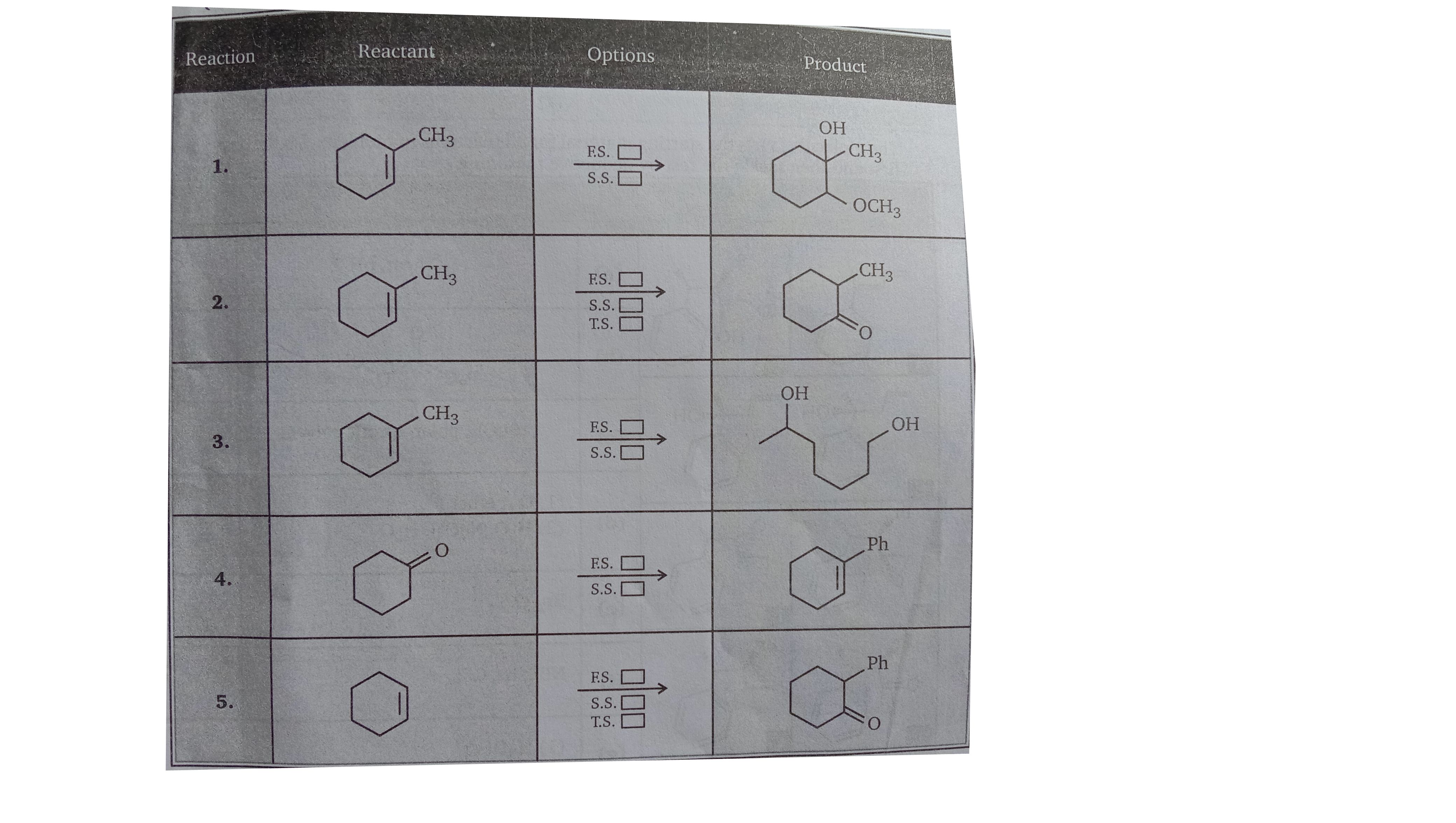Devise a series of reaction to convert benzene into meta - chlorobromobenzene. Select rangent and condition from following table listing them in the order of use.

1 them 2 them 6
2 them 8 then 4 then 3 them 9
8 then 4 then 10 then 2 then 2 then 3 then 9
8 then 2 then 4 then 3 then 9
The correct Answer is:D
Step by step video, text & image solution for Devise a series of reaction to convert benzene into meta - chlorobromobenzene. Select rangent and condition from following table listing them in the order of use. by Chemistry experts to help you in doubts & scoring excellent marks in Class 12 exams.
Updated on:21/07/2023Topper's Solved these Questions
- AROMATIC HYDROCARBONSBOOK - HIMANSHU PANDEYCHAPTER - AROMATIC HYDROCARBONSEXERCISE - Level 3 (Q.126 To Q.150)
25 Videos
- AROMATIC HYDROCARBONSBOOK - HIMANSHU PANDEYCHAPTER - AROMATIC HYDROCARBONSEXERCISE - Level 3 (Q.151 To Q.160)
10 Videos
- AROMATIC HYDROCARBONSBOOK - HIMANSHU PANDEYCHAPTER - AROMATIC HYDROCARBONSEXERCISE - Level 3 (Q.76 To Q.100)
25 Videos
- AMINESBOOK - HIMANSHU PANDEYCHAPTER - AMINESEXERCISE - Subjective Type Problems
5 Videos
- BIOMOLECULESBOOK - HIMANSHU PANDEYCHAPTER - BIOMOLECULESEXERCISE - Match The Column
6 Videos
Similar Questions
In each reaction box write a single letter designating the best reagent and condition selected from the list at bottom of the page.


View SolutionNitrobenzene is a versatile compound that may be converted inot a wide variety of subsituted benzenes. Five such synthesis are shown below. In each reaction box above an arrow write letters designating the reagents and conditions, selected from the list at the bottom of the page, that would effect the transformation. The reagents must be written in the answer box in the correct order of their use. You may assume appropriate heating or cooling takes place, and more than one equivalent of the reagent may be used if needed.

ReagentsReagentsAH2,NicatalystFCl2 & FeCl3BKBr & Cu2Br2GNaOH10% solutionCKCN & Cu2(CN)2H(CH3CO)2O, pyridineDHNO20∘CIHNO3/H2SO4ECH3I & pyridine
View Solution
Knowledge Check
Devise a series of reactions to convert benzene into meta-chlorobrombenzene. Select reagents and conditions from the following table, listing them in the order of use
CompoundCompoundCompound1Sulphuric acid (conc.) heat5Mgin ether9Cu2Br2+HBr2Cl2+FeCl3 and heat6PBr310(CH3CO)2O+ Pyridine3NaNO2+H3O(+)0∘C7H3PO24H2 Pt catalyst8HNO3(conc.)+H2SO4(conc.) and heatA1 then 2 then 6B2 then 8 then 4 then 3 then 9C8 then 4 then 10 then 2 then 3 then 9D8 then 2 then 4 then 3 then 9Derice a series of reaction of convert benzene into metachlorobromobenzene. Select reagents and condition from the following table, listing then in the order of use.
(1) sulphuric acid (conc.) heat
(2) Cl2+FeCl3 and heat
(3) NaNO2+H2O+,0∘C
(4) H2,PdC catalyst ltbtgt (5) Mg in order
(6) PBr3
(7) H3PO2
(8) HNO3(conc.)+H2SO4(conc.) and heat
(9) Cu2Br2+HBr
(10) (CH3CO)2O+ pyridineA8 then 2 then 4 then 3 then 9B2 then 8 then 4 then 3 then 9C8 then 4 then 10 then 2 then 3 then 9D1 then 2 then 6In order to prepare fluorobenzene from benzene diazonium chloride which of the following reagent is used
AFluorineBHFCHydrofluorosilicic acidDFluoboric acid
Chlorobenzene can be converted into phenol by heating in aqueous sodium hydroxide solution at temperature of 623K and a pressure of 300atm. However the rate of reaction can be increased by presence of certain groups in benzene ring. What will be the order of reactivity of following compounds towards the above substitution reaction?


View SolutionA company selected 4000 households at random and surveyed them to find out a relationship between income level and the number of televisions sets in a home. The information, so obtained is listed in the following table.

Find the probability
i) of a household earning Rs 10000- Rs 14999 per year and having exactly one television.
ii) of a household earning Rs 25000 and more per year owning 2 televisions.
iii) of a household not having any television.
View SolutionThe diagrams below show cells in various phases of the cell cycle. Note the cells are not arranged in the order in which the cell cycle occurs. Use these diagrams to answer the following questions.

List the diagrams in order from first to last in the cell cycle.
View Solution(a) Explain how the sterochemistry of SN1 and SN2 differs.
(b) Explain the formation of 60% inverted and 40% racemic product from a typical SN1 reaction.
(c) Account for the following in terms of the rate of solvent in the above problem.
(i) The reaction is first order.
(ii) Under what conditions the rate expression is more than first order ?
(iii) What is the order and molecularity ?
View SolutionWithout looking at the periodic table, select the elements belonging to same from the following list.
View Solution
